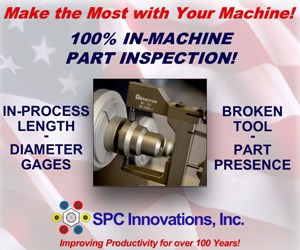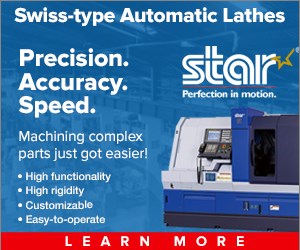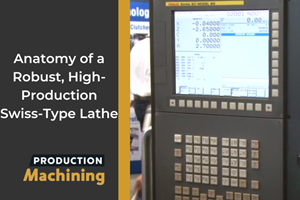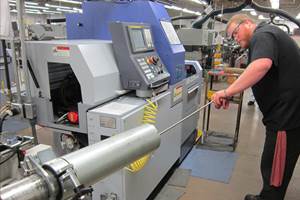High Speed Spindles For Swiss Machining
This article discusses the use of high-speed spindles in Swiss machining applications. Sufficient rotational speed is necessary to take advantage of tooling materials in small diameter cutters.
One of the main reasons that CNC Swiss machine tools are among the hottest technologies in the precision machined parts industry is the versatility they bring to part production. Much of this versatility is represented by the machines’ ability to perform multiple operations including turning, drilling and milling.
Specialty machining shops and traditional turning shops are looking at Swiss in large part because of its ability to process workpieces complete in a single handling. Moreover, with automatic workhandling such as CNC-controlled bar feeder units, these machines lend themselves to untended or lightly tended operations.
The turning capabilities of Swiss machines are well known. The single-axis plunge of the cutting tool, close coupled to the guide bushing results in high-accuracy turning on long, slender parts. Increasingly, production requirements on Swiss machines incorporate what were once secondary operations, such as drilling and detailed milling.
Most driven tools on CNC lathes are limited to about 5,000 rpm. For larger-diameter tools, this speed limit is not a problem. However, much of the work on Swiss machines is in small diameters. For small-diameter drills and mills, high rotational speed is critical to maximize feed rates and, in combination, provide productive cutting speeds. High-speed spindles can often reduce drilling cycle times (usually the slowest operation) by a factor of five.
Swiss manufacturer of precision high-speed spindles, Ibag, has introduced micro-precision high-speed milling and drilling spindles specifically for the Swiss machine (automatic CNC lathe) market. The new products include a 25-mm diameter 60,000-rpm model (80,000-rpm optional), as well as a 22-mm-diameter 60,000-rpm model.
By using small-precision milling spindles as live tooling on the Swiss machine, it is possible to perform delicate milling operations on the original setup. The high speed, power and rigidity of the spindle allow small end mills to be used at high speeds in stainless steel, brass and other alloys. The use of high-speed cutting techniques (shallow depth of cut and faster feeds) also minimizes burrs.
These spindles are dynamically balanced to ensure that the spindle runs smoothly and quietly with little to no vibration at all speeds. Excessive vibration not only reduces bearing life, it also shortens tool life and can even cause small tool breakage.
The spindles are compact and powerful, using DC brushless motor technology. The DC brushless technology allows the use of a small-sized motor that has higher power and runs cooler than standard AC motor technology. High power and high torque are required when milling tough materials like stainless steel, brass and other alloys.
For thermal stability, the spindles are air-cooled and require no external cooling by water or fans. The bearings used (both front and rear) are sealed hybrid-ceramic (steel races and ceramic balls), with permanent grease-packed lubrication. The spindle design includes an integral positive over-pressure air-seal. The air seal system injects a small amount of compressed air through the stainless steel spindle body, and ensures that dirt, coolant and other contamination does not enter the spindle housing. This protects the spindle bearings, extends spindle life and increases uptime, which is critical for high-production applications.
The maximum allowable taper runout is 2 microns. Higher runout values, even in the micron range, can adversely affect the cutting quality and accuracy of micro-tooling. It is impossible to drill with a tool diameter of 0.020 inch when the runout of the tool may be in the 0.001-inch range. The tool will walk, wear excessively, and in many cases, immediately break when it touches the workpiece. Tool retention on these Ibag spindles uses a precision ER-8 collet system, with a maximum tool shank diameter of 3/16 inch (5 mm).
The spindle can be integrated with the CNC to control operation (on/off and speed), and to monitor any faults by the CNC. As the spindle speed is programmable from the CNC, it is a simple task to change over to a new part by re-programming the required speed for each spindle cutting tool. The CNC interface can use spare M codes to activate the spindle as needed.
The use of micro high-speed spindles, on Swiss-style turning equipment, will provide a means to optimize operations that are traditionally the most challenging, and consume the most cycle time on a small part. With the development of new machines with even smaller footprints, smaller spindles (20 mm and 16 mm) may play an even greater role in making the best efficiency and through-put possible.
Related Content
Getting More Production From Swiss Turning Centers
Buying a new CNC Swiss turning center is a substantial investment. For the best return, look closely for capabilities that enable the best utilization of the machine.
Read MorePursuit of Parts Collector Spearheads New Enterprise
While searching for a small parts accumulator for Swiss-type lathes, this machine shop CEO not only found what he was looking for but also discovered how to become a distributor for the unique product.
Read MoreVideo Tech Brief: Anatomy of a Robust, High-Production Swiss-Type Lathe
This Swiss-type is equipped with a total of 52 tools, including a 40-tool magazine, 10 tools on the back tool post, and an optional 2 tools on the deep hole drill holder.
Read More6 Tips for Training on a Swiss-Type Lathe
There are nuances to training a person to effectively operate a Swiss-type lathe. A shop I visited a while back offers some suggestions.
Read MoreRead Next
Emerging Leaders Nominations Now Open
Here’s your chance to highlight a young person in your manufacturing business who is on the path to be a future leader moving your company forward.
Read MoreA Tooling Workshop Worth a Visit
Marubeni Citizen-Cincom’s tooling and accessory workshop offers a chance to learn more about ancillary devices that can boost machining efficiency and capability.
Read More5 Aspects of PMTS I Appreciate
The three-day edition of the 2025 Precision Machining Technology Show kicks off at the start of April. I’ll be there, and here are some reasons why.
Read More








.jpg;maxWidth=300;quality=90)












